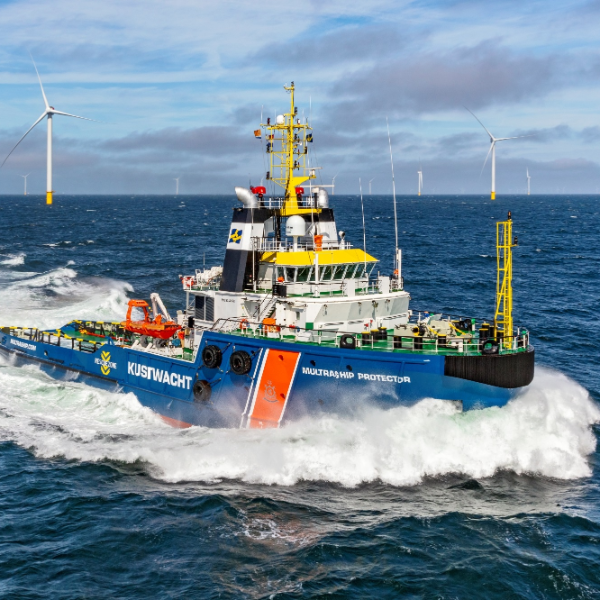Power2Tow
Exploring the future of electric charging at sea for Rijkswaterstaat

Power2Tow
How do you ensure that electric emergency response vessels are available in the North Sea when and where they are most needed? That question was central to a recent study by engineering consultancy Witteveen+Bos, in close collaboration with Haskoning. The result is a blueprint for charging infrastructure at sea, in the middle of the North Sea. The study was assigned by Rijkswaterstaat and was co-financed by the European Recovery and Resilience Fund.
An emission-free fleet in an increasingly busy North Sea
The North Sea is changing, both literally and figuratively. The number of offshore wind farms and ship movements is increasing, as is the risk of maritime incidents. Rijkswaterstaat is responding to this by electrifying its fleet of Emergency Response and Towing Vessels (ERTVs), with the aim of achieving 90 % emission-free deployment. However, without power, action is impossible. This requires smart and reliable charging infrastructure, both onshore and offshore.
The Power2Tow project
Within the broader Power2Tow initiative, three ERTVs are being developed that will be largely electric, with additional methanol capacity. At the same time, five charging locations are being developed offshore and five onshore. Witteveen+Bos was commissioned to determine which locations and types of charging infrastructure are most suitable, based on the research question: which locations and forms of electric charging infrastructure in the North Sea best match the operational profile of a sustainable ERTV?
Combining technology, risk and realism
The approach consisted of discussions with relevant parties, including TenneT, offshore wind farm developers, charging system suppliers and the Coast Guard. These discussions were supplemented by technical analyses and input from MARIN.
The research focused on three areas: identifying promising charging locations at sea, determining the technical and legal conditions for grid connection, and investigating the available systems for offshore charging. Ultimately, five potential charging zones were selected, strategically located near wind farms and away from ecologically sensitive areas, busy shipping routes and military exercise zones.
Charging locations near power and risk areas
A suitable charging location must not only be close to a reliable source of electricity, such as a wind turbine or a TenneT offshore substation, but must also be positioned in such a way that ERTVs can reach an emergency location within two hours, even in poor weather conditions. The five selected areas combine strategic location with technical feasibility. The locations were assessed using a evaluation matrix that took into account technical, financial, spatial, legal and planning aspects. An important finding is that a direct connection to individual wind turbines is often more efficient and sustainable than connection to a central substation.
Charging systems: fixed construction or floating solution
Two offshore charging concepts have been investigated. The first is the e-tower, a fixed charging station mounted on a monopile, similar to the foundation of a wind turbine. The second is the e-buoy, a floating charging station anchored to the seabed. Although both solutions are technically feasible, the e-tower is preferred. It is more robust under North Sea conditions, can withstand waves up to ten metres high, and is easier to integrate into existing offshore wind farm infrastructure.
Technical and legal challenges
Connection to a wind turbine or substation requires voltage and frequency conversion, as well as minimum cable length and sufficient space on the platform. At the same time, there are legal obstacles, as the current regulatory framework does not yet allow energy to be supplied to ships via the offshore grid. Contractual agreements on energy supply must also offer sufficient certainty. Safety also plays a major role: the charging system must enable safe mooring, even in changing conditions, and be able to disconnect quickly in case of an emergency. In addition, distances to other infrastructure, such as turbines and shipping lanes, must be carefully safeguarded.
Next steps: technology development and standardisation
In addition to the choice of location and system design, the study emphasises that further development of offshore charging infrastructure is necessary. The technology is still in its infancy. To enable large-scale and safe application, further steps are needed, including standardisation of connectors, communication protocols and grid integration, technical specifications for compatibility between ships and charging systems, testing and certification procedures, and alignment with existing regulations, such as IEC 80005 and the EMSA guidelines.
Witteveen+Bos has also conducted a follow-up study in which these aspects are further elaborated. Together with developers of high-power charging systems and other parties involved, the current technical readiness and the extent to which existing or future international standards can contribute to practical application are being examined.

On course for emission-free shipping
The Power2Tow project of Rijkswaterstaat is an important step in the transition to emission-free maritime operations in the North Sea. It is great to be able to contribute to this with technical and strategic expertise. With a multidisciplinary approach and a focus on practical feasibility, we are contributing to the development of a cleaner, more resilient future, both at sea and on shore.
More information?
